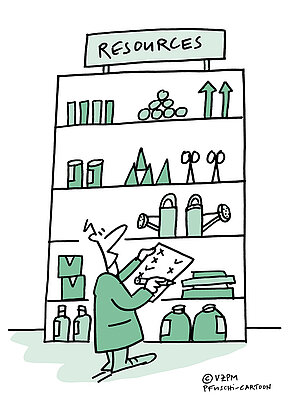Resources
Definition
The resources competence element includes defining, acquiring, controlling and developing the resources that are necessary to realising the project’s outcome. Resources include people, expertise, facilities, equipment, materials, infrastructure, tools and other assets required to carry out the activities according to the objectives. This competence element includes defining a strategy for acquiring and utilising the resources for the best performance of the project, optimising the utilisation of the resources given the time and financial constraints and the continuous monitoring and control of these.
Purpose
The purpose of this competence element is to enable the individual to ensure that the resources required are available and assigned as needed in order to meet the objectives.
Description
To realise its objectives, a project needs resources. Managing resources means applying a proper approach to defining and obtaining these resources. Resource allocation must be prepared during the planning phase and should be continuously monitored and adjusted throughout the whole lifecycle of the project. The individual should make sure that the personnel have the necessary competences and that they are provided with adequate information, tools and training to perform the required tasks successfully. Since resource needs and availability change regularly, for both controllable and uncontrollable reasons, resourcing is a continuous or regular process.
In the case of projects, individuals often have to negotiate with the permanent organisation or external service providers in order to obtain the desired resources. With some kinds of resources, conflicts in availability may occur, due to unexpected events such as funds shortage, performance troubles, equipment failure, weather, labour unrest, etc. Such conditions may require re-scheduling of activities and a change in the resources involved in the current or subsequent activities, especially if critical activities are affected by such events. Procedures should therefore be put in place to identify such unexpected events and ensure that the necessary adjustments are made as soon as possible.
Key competence indicators
Develop strategic resource plan to deliver the project
The strategic resource plan stipulates who is responsible for which part of the resource definition, resource allocation, resource development, resource distribution and resource freeing. Responsibilities may lie with the programme manager if the project is part of a programme, with the constituent organisations, with resource managers or with the underlying projects. The strategic resource plan needs to be in line with the schedule. The individual develops, organises and assesses a plan and adapts it to changes whenever needed.
Measures
- Identifies project resource requirements based on resource forecasts
- Captures baseline of existing and proposed resources
- Reviews and analyses the resource capacity of the organisation and identifies trends
- Coordinates with constituent organisation or portfolio management processes
Define the quality and quantity of resources required
The individual must identify the resources (type, quantity and quality) that are needed to successfully deliver the project results, based on the strategic resource plan. Resources include people, expertise, facilities, equipment, materials, infrastructure, tools, non-financial funds or services. After identifying these resource needs, a more detailed analysis is conducted that defines when the resources need to be available and of what quality and in what amount they are needed. This may result in a detailed operational resource plan(s).
Measures
- Describes the resources needed for the project
- Draws up a resource plan (based on detailed project planning)
- Defines the amount and quality of the required resources
Identify the potential sources of resources and negotiate their acquisition
Once the needed resources have been defined, the right resource providers must be identified. Resources can be sourced with the organisations, or with commercial parties. Many organisations provide sourcing guidelines that have to be followed. Especially when ‘make or buy’ decisions have to be taken, the individual must rely on formal and informal networks. A good knowledge of the organisation, as well as a broad overview of the markets for resources, is necessary, in order to create and decide on sourcing alternatives. Obtaining external resources is very different from allocating internal resources. While acquiring internal resources is merely a question of availability and quality, the costs for external resources also have to be negotiated.
Measures
- Takes ‘make or buy’ decisions
- Creates and evaluates sourcing alternatives
- Defines a sourcing strategy
- Engages with resource providers
- Negotiates resource availability
Allocate and distribute resources according to defined need
Resource allocation means assigning resources to specific projects or activities. This enables monitoring, controlling and management of the resources, their results and the related costs. Allocating resources is in general closely linked to scheduling. Changes in the schedule and changes in the resource availability or quality often affect each other. Some specialities have to be taken into account when human resources are allocated, as productivity or learning speed may differ between individuals. The resources that are contracted need to be distributed within the project according to needs and according to the strategic resource plan. The conditions under which resources are contracted need to be adhered to. When there are conflicting resource needs, the individual needs to consider all options and come up with the best way to handle these needs, based on priorities, urgency, or other criteria. Measures to overcome resource shortage have to be developed and implemented. The individual has to be able to organise the resource distribution and adapt it as necessary. This is the case not only for the resources the individual is directly responsible for, but also for resources critical to the delivery of benefits that are under the jurisdiction of other parties (stipulated by the strategic resource plan).
Measures
- Links resources with project structure
- Creates schedules (or task lists) for resources
- Negotiates resource conflicts
Evaluate resource usage and take any necessary corrective actions
All the relevant resources parameters and indicators must be monitored to ensure the proper usage of resources. Evaluating resources entails applying a systematic approach in order to derive productivity numbers. When required, the individual should take corrective action. In the case of over- or understimation new assignments must be checked.
The individual should also regularly evaluate the quality and availability of assigned resources. In the case of external resources, consultations with suppliers and other contractors may be necessary in order to improve or exchange the resource. The performance of people may have to be improved. These people would then need development, coaching and specific training measures. This should be negotiated and coordinated with the resource suppliers. The individual is responsible for allocating and re-allocating critical resources, even beyond the resources for which the individual is directly responsible.
Measures
- Defines a systematic approach to evaluating the use of resources
- Provides opportunities to enhance competences/skills
- Addresses a skill shortage with the relevant team member and his or her line management


